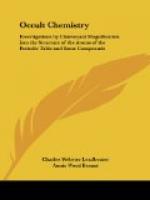NITROGEN (Plate XII, 1) does not assume the cubical form of its relatives, but is in shape like an egg. Referring again to our 1895 investigations, I quote from them. The balloon-shaped body (see 4 a) floats in the middle of the egg, containing six small spheres in two horizontal rows, and a long ovoid in the midst; this balloon-shaped body is positive, and is drawn down towards the negative body b (see 4 b) with its seven contained spheres, each of which has nine atoms within it—three triads. Four spheres are seen, in addition to the two larger bodies; two of these (see 4 d), each containing five smaller globes, are positive, and two (see 4 c) containing four smaller globes, are negative.
NITROGEN: Balloon 110
Oval
63
2
bodies of 20 atoms 40
2
" " 24 " 48
——
Total
261
——
Atomic
weight 14.01
Number
weight 261/18 14.50
VANADIUM (Plate XII, 2) closely follows scandium,
having two types of
funnels. Funnel A only differs from that of scandium
by having a globe (see
4 d) inserted in the ring of four ovoids; funnel
B has a six-atomed,
instead of a five-atomed globe at the top, and slips
a third globe
containing twenty atoms (see 4 d) between the
two identical with those of
scandium (see 4 c). The central globe
has seven atoms in its middle body
instead of four. In this way does vanadium succeed
in overtopping scandium
by 126 atoms.
VANADIUM: 3 funnels (A) of 160 atoms 480
3
" (B) " 137 " 411
Central
globe 27
——
Total
918
——
Atomic
weight 50.84
Number
weight 918/18 51.00
NIOBIUM (Plate XII, 3) is as closely related to yttrium
as is vanadium to
scandium. The little globes that scamper round
the “cigars” contain twelve
atoms instead of eight (see 4 e).
The rest of the funnel is the same. In the central globe both the tetrahedra have “cigars,” and a central nine-atomed globe spins round in the centre (see 4 f), seventeen atoms being thus added.
NIOBIUM: 6 funnels of 277 atoms 1662
Central
globe 57
——
Total
1719
——
Atomic
weight 93.25
Number
weight 1719/18 95.50
III a.—Aluminium, gallium and indium were
examined from this group. They
are triatomic, diamagnetic, and positive. The
corresponding group contains
phosphorus, arsenic and antimony: bismuth also
belongs to it, but was not
examined; they are triatomic, diamagnetic and negative.
They have no
central globes.




